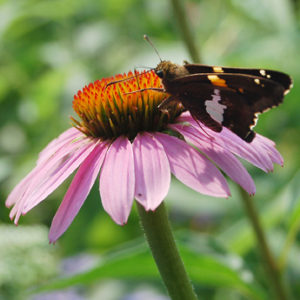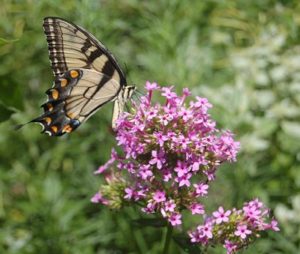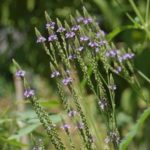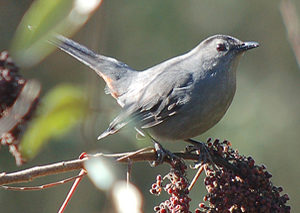This year 2019, marks the fifth year for our pollinator garden here on the Rachel Carson House grounds. The garden has a long, narrow, oval aspect and is surrounded by a 4 foot high fence to exclude Deer, Groundhogs, and Rabbits.
As of mid-August, the numbers and varieties of Butterflies observed during a few minutes spent in the garden range in number from 20-40 and in size from tiny ones such as the Pearl Crescents to mid-sized Silver Spotted Skippers and the larger Tiger Swallowtails. All these Butterflies have joined a variety of other pollinators in visiting the blooms. This summer, however, we have seen fewer Bumblebees and other Bees than in previous years and more Wasps and small Flies than last year. Also, a few Dragonfly visitors have been seen this year, (after an absence of several years).
Note: There is no indication that any person visiting the garden has ever been stung. The Bees, (most of which are native) and the Wasps don’t seem to be bothered by our routine garden activities and even our close observations of their work. We in turn make no attempt to handle them.
The favorite nectaring plants of the Swallowtail and the smaller Skipper butterflies have been the 5 foot tall purple phlox (Phlox paniculata ‘jeana’), which have been blooming continuously since early August.
Other plants that are attracting Butterflies include the Joe Pye Weed group, which has been represented in the garden since its beginning. Both the seven foot tall, (Eutrochium fistulosum), and the shorter (five foot) varieties are visited by Butterflies.
The first Thistle opened on August 19th and its feathery, pale purple blossom has drawn in Tiger Swallowtails to enjoy its nectar.
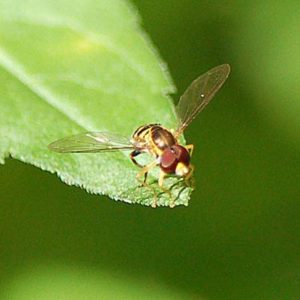 Blue Vervain (Verbena hastata), a relatively new planting is attracting the smaller Butterflies (Skippers and others) plus small Bees and very small Bees. Its unique cluster of blooms also draws the attention of human visitors. Reaching a height of 4 feet the branches terminate in a cone-like point with a delicate skirt of purple-blue flowers at the wide end — a quite distinctive appearance.
Blue Vervain (Verbena hastata), a relatively new planting is attracting the smaller Butterflies (Skippers and others) plus small Bees and very small Bees. Its unique cluster of blooms also draws the attention of human visitors. Reaching a height of 4 feet the branches terminate in a cone-like point with a delicate skirt of purple-blue flowers at the wide end — a quite distinctive appearance.
Mountain Mint (Pycnantheum muticum) plants, long time residents in the garden and in a nearby spot just outside the garden’s fence have been visited by Bumblebees, small Bees and Wasps again in 2019 as in past years. Mountain Mint and other mints in bloom at this time survive outside the fence because they are not browsed by deer.
Anise Hyssop (Agastache foeniculum) planted this season has attracted many Bumblebees and has been in bloom since late June.
We are eagerly awaiting the blooming of our Turtlehead plants both the pink and the white. Their green buds are starting to show petals.
Feathered guests also are attracted by our pollinator garden. Quite a few Goldfinch have been observed visiting the Joe Pye Weed and a solitary Hummingbird was seen nectaring at the native Honeysuckle plant. Goldfinch also have been visiting Purple Cone flowers for their post-blooming seeds. The House Wrens are also regular visitors as they search for insects. They raised a family in the nest box we placed for them in the Magnolia tree close to the garden.
For a number of years Gray Catbirds have nested on the Carson property and this year they have adopted the pollinator garden as their special place: for a drink of water, a splash in the bird bath and the opportunity to forage on the ground for insects. We look forward to their return next spring (from Panama or Bermuda where they winter), and will welcome their songs and their charming companionship.
Rachel Carson mentioned Catbirds In Silent Spring’s first chapter, “A Fable for Tomorrow.” In it she described a mythical town where the loss of songbirds resulted from the combined actual hazardous effects reported following widespread applications of insecticides (including DDT, aldrin, dieldrin, and parathion) in different locations. She wrote: “In the mornings that had once throbbed with the dawn chorus of robins, catbirds, doves, jays, wrens and scores of other bird voices there was now no sound; only silence lay over the fields and woods and marsh.”
Most of the chemical pesticides described in Silent Spring are now banned. Unfortunately, among their replacements available today, are widely used pesticides that have been found to directly and indirectly harm birds and other non-target life forms (Footnote)
Pesticides indirectly harm wildlife when they remove from the ecosystem critical non-target plants, and insects that provide the wildlife with the food and habitat needed for their survival. Except for provisions of the Endangered Species Act pesticide regulations do not offer protection from this indirect harm to wildlife. Rachel Carson wrote: “To destroy the homes and food of wildlife is perhaps worse in the long run than direct killing.” (p. 74, Silent Spring)
Our pollinator garden was established and is maintained without use of any pesticide applications. Located at the place where Silent Spring was written, we like to think that it’s the kind of garden that would have pleased Rachel Carson.
Diana Post, Cliff Hall and Staff of RCLA
8-28-19
Footnote:
A few examples of current pesticides’ direct adverse effects on wildlife
- Neonicotinoid insecticides, a widely-used group of chemicals, have been found lethal to birds as well as to the aquatic systems on which they depend, (Mineau, P., “The Impact of the Nation’s Most Widely Used Insecticide on Birds,” 2013)
- Clothianidin and thiamethoxam two neonicotinoid insecticides have been found harmful to pollinators. (Ellis v. EPA)
- Clothianidin, a neonicotinoid insecticide, has been found potentially harmful to monarch butterflies in the field. Its use may be contributing to monarch population declines. (Pacenka, J, Lundgren, J., “Non-target effects of clothianidin on monarch butterfies,” Sci Nat (2015) 102: 19)
- Imidacloprid, a neonicotinoid insecticide, at low exposure levels over an extended period has been found to negatively affect honeybee foraging and learning behavior (Fossen, M., “Environmental Fate of Imidacloprid,” California Dept. of Pesticide Regulation, April 2006)
- Professor Rick Relyea (U. of Pittsburgh) found that at the manufacturer’s recommended application rate, the widely-used herbicide, Roundup with the active ingredient glyphosate, eliminated Leopard Frog and Gray Treefrog tadpoles. (Cauble, et al., “Sublethal effects of the herbicide glyphosate on amphibian metamorphosis and development,” Bulletin of Environmental Contamination and Toxicology, 75, 2005, 429-435)

